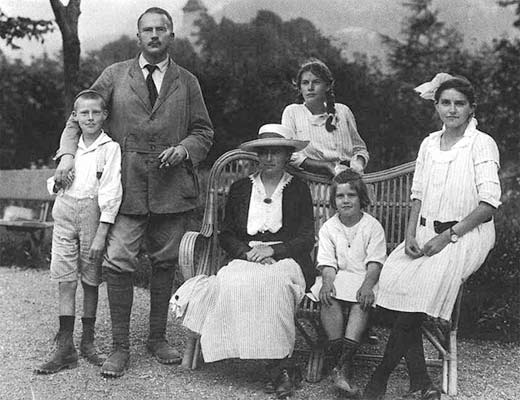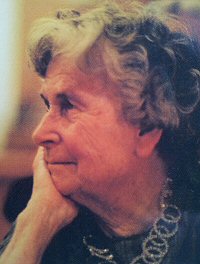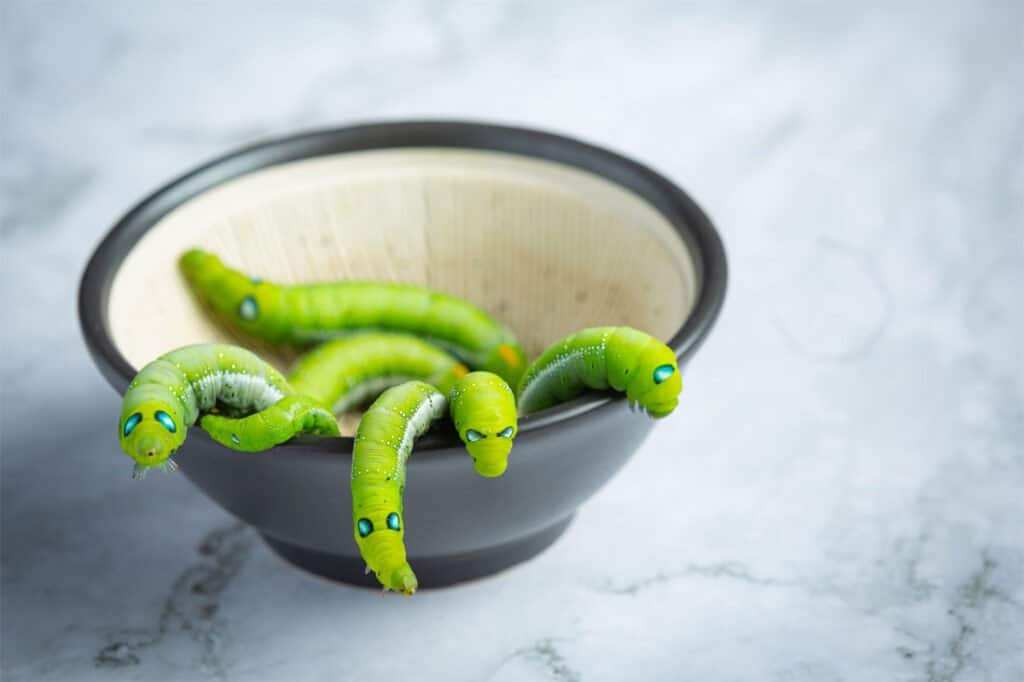Carl Gustav Jung, the eminent Swiss psychiatrist and psychoanalyst who founded analytical psychology, had a notable personal life marked by his marriage and his role as a father. Jung married Emma Rauschenbach in 1903, who was not only his wife but also became an integral collaborator in his research and explorations into the depths of the human psyche. Together, they navigated both the challenges and triumphs of life, with Emma’s financial inheritance playing a crucial role in facilitating Jung’s work.

The couple was blessed with five children: Agathe Niehus, born in December 1904; Gret Baumann, born in February 1906; Franz Jung-Merker, their only son, born in November 1908; Marianne Niehus, born in September 1910; and Helene Hoerni, born in March 1914
Emma Jung (Rauschenbach)

Born March 30, 1882, in Schaffhausen, Died November 27, 1955, in Zurich
Emma Jung (née Rauschenbach) was a key figure in the life of Carl Gustav Jung, not only as his wife but also as a collaborator and support in his scientific work. Born into a wealthy Swiss-German industrialist family, Emma provided significant financial support that allowed Jung to devote himself to research in the field of depth psychology without having to worry about daily material concerns.
Emma and Carl met when she was 16, and he was 21. Their relationship quickly turned into a deep bond, formalized when they married on February 14, 1903. This marriage was the beginning of a long and fruitful journey, where Emma not only supported Carl in his personal and professional challenges but also developed herself as a psychologist.
With a strong interest in her husband’s work, Emma Jung decided to deepen her knowledge of psychology. Her intellectual curiosity and engagement in psychological topics led to her own studies and research, especially in the area of psychology of women and family relationships. Her contribution to the development of analytical psychology, though often overshadowed by her husband’s achievements, was significant, especially in understanding the dynamics of marriage and family.
Between 1904 and 1914, Emma and Carl Jung welcomed five children into the world – one son and four daughters, further strengthening their family and personal bonds. Being the mother and partner of one of the most distinguished thinkers of the 20th century was not easy, but Emma showed an extraordinary ability to balance family life and her own intellectual aspirations.
Emma Jung died on November 27, 1955, leaving behind a rich legacy as a mother, wife, and scientist. Her death was a deep blow to Carl, who described her as the foundation of his home and “the Queen”. This metaphor not only highlights the deep affection he had for his wife but also acknowledges her role as a pillar of the family and an important figure in his professional life.
Children
Agathe Niehus
1904 – 2014

Agathe Niehus (née Jung) was the daughter of the famous Swiss psychiatrist Carl Gustav Jung. She was born on December 28, 1904, in Zurich, Switzerland, and died on April 8, 2014, also in Zurich, at the age of 109 years.
Agathe was born and raised in Zurich, where she received her education. From a young age, she showed an interest in art, which directed her professional career towards painting and sculpture. As a talented artist, Agathe had the opportunity to present her works in various Swiss galleries, gaining recognition in the artistic community. Her creations, imbued with a deep understanding of the human psyche, perhaps reflected the influence of the intellectual environment in which she grew up.
Agathe was also an avid traveler who visited many countries in Europe and Asia. Her travels likely not only expanded her artistic horizons but also allowed for a deeper understanding of cultural diversity, which could have been an inspiration for her works.
One of the most significant events in Agathe Niehus’s life was the publication of “The Red Book” – a collection of personal writings and reflections by her father on his life and work. Carl Gustav Jung’s “The Red Book” is considered one of his most important works, in which he delved into the depths of the unconscious and the process of individuation. Agathe played a key role in preparing this book for publication, which testifies to her significant contribution to preserving and popularizing her father’s intellectual legacy. The book was a great success, contributing to even greater recognition of Jung’s work.
In her private life, Agathe was married to Hans Niehus, with whom she had two children: Ursula and Peter. Her family and professional life showcase a multifaceted figure who not only inherited intellectual passions from her father but also developed her own interests and artistic talent.
Gret Baumann
1906 – 1995

Gret Baumann (née Jung) was the second daughter of Carl and Emma Jung, born in 1906 at the Burghölzli Psychiatric Clinic in Zurich, where her father worked with Eugen Bleuler at the time.
Gret Baumann (née Jung), the second daughter of Carl and Emma Jung, maintained a strong interest in astrology throughout her life, which began when she was just fifteen years old. Her passion and dedication to astrology earned her recognition as one of the most famous astrologers in the Zurich area.
At the age of twenty, she married Fritz Baumann, who held a doctorate in law and economics. When Fritz Baumann became the managing director of a Swiss steel company in Paris in 1926, they moved to France, where they lived for twelve years.
During their stay in France, Mrs. Baumann-Jung actively participated in the activities of Gros Caillou, the Parisian Psychological Club, organizing conferences dedicated to astrology. Wanting her future children to retain Swiss citizenship, she traveled to her grandmother, Berta Rauschenbach (Emma Jung’s mother), for each childbirth, so that her first three sons were born in Switzerland. The fourth son was born in France due to premature birth.
In September 1939, at the start of World War II, Gret went on vacation with her four sons to the family home in Küsnacht. During this visit, Germany attacked the Netherlands, and Carl Jung was placed on the Germans’ blacklist. Together, they hid in the mountains, seeking protection. Faced with the war and uncertainty about future events in France, everyone agreed that Mrs. Baumann-Jung should stay with her four sons in Küsnacht with her parents. Thus, they lived together in the home of Carl Gustav and Emma Jung for three years.
After the occupation of France ended, Fritz Baumann found work in Switzerland and returned to his homeland in 1945, at the end of the war. Two years later, their fifth and last son was born.
According to Dieter Baumann, Carl Jung emphasized the importance of his children forging their own paths. Gret passed on the same values of respect and support to her own children, showing how important it is for everyone to develop according to their own beliefs and passions.
Franz Jung-Merker
1908-1996
Franz Jung-Merker, the third child and only son of the famous psychiatrist Carl Gustav Jung and Emma Jung, was born on November 28, 1908, in Küsnacht, in the Meilen district, near Zurich, Switzerland. He passed away on June 29, 1996, also in Küsnacht, at the age of 87. Professionally, Franz Jung-Merker dedicated his life to architecture, choosing a path that allowed him to creatively express his vision and interpretation of space.
His career reflected a passion for design and the creation of functional yet aesthetically appealing buildings that responded to the contemporary needs and architectural trends of the time. As an architect, Franz Jung-Merker was able to explore the relationship between form and function, striving for harmony between the inhabited space and its surrounding environment.
Franz Jung-Merker was also the father of two sons, Peter and Andreas, signifying the continuation of the Jung family legacy. While information on his personal and professional life is more sparse compared to other members of the Jung family, his role as a father and his contributions to the field of architecture undoubtedly had a significant impact on his immediate surroundings and the family legacy.

Franz Jung (1908-1996) on the left side, and his two sons: Peter and Andreas, on the right. In the painting behind Peter and Andreas is Johann Paul Achilles Jung, 1842-1896, the father of Carl Gustav Jung – a pastor of the Swiss Reformed Church. Paul’s grandfather was reportedly Johann Goethe.
Franz and Andreas were architects. Andreas currently lives in the Jung house in Küsnacht. Peter is a Jungian analyst.
Marianne Niehus
1910-1965
Marianne Niehus (née Jung), the fourth child of Carl Gustav Jung, later known as Niehus Jung, played a crucial role in organizing and publishing her father’s works. The early stages of Jung’s career, before he employed Marie-Jeanne Schmid, were characterized by collaboration with family members on secretarial matters. Initially, his sister Gertrud assisted him from 1909-1926, later these tasks were taken over by Emma Jung, until 1930, when Marianne assumed these duties for two years.
Marianne was the first to begin systematically archiving her father’s letters, significantly contributing to the preservation of his intellectual legacy. Towards the end of her life, from 1956 until her death in 1965, she served as one of the co-editors of “Gesammelte Werke” (Collected Works of Carl Gustav Jung, German edition), which attests to her significant contribution to cementing her father’s legacy. From 1958, she was also a member of the subcommittee responsible for the publication of “C. G. Jung Briefe” (Letters of Carl Gustav Jung, German edition), further highlighting her important role in managing Jung’s literary heritage. Her work was immensely important in enabling a wide audience access to the thoughts and theories of one of the most important thinkers of the 20th century.
Helene Hoerni
1914-2014

Helene was born and raised in Küsnacht, a small town by Lake Zurich, which remained her home throughout her life. She described herself as a delicate and sensitive child, for whom the lake held greater significance than the surrounding world. Before dedicating herself to the art of icons, Helene acquired tailoring skills, working in ateliers in London and Paris, and even briefly running a tailoring studio in Zurich. After marrying Konrad Hoerni, sewing became a private passion for her.
The tragic death of her husband led Helene to search even more intensely for answers to existential questions, which led her to in-depth studies of the mysticism of icons in Orthodox Christianity. In icons, she found a “comprehensive image of God” and a way in which “divine light manifests itself in earthly life.” Her work on icons was summarized in two books, which were recognized for their deep understanding of the subject.
In her private life, Helene was a mother, grandmother, and great-grandmother who passed on respect and support for their own life paths to her children, in line with her father’s teachings. During World War II, facing threats, she took refuge with her children in her parents’ home in Küsnacht, where they spent three years together.
Helene Hoerni-Jung not only continued her father’s spiritual search but also found her own path, exploring the mysticism and spirituality of icons. Her life was an example of deep spiritual reflection and extraordinary intuitive power, which allowed her to reach the essence of human spirituality and share this discovery with others.
Bibliography
- Clay, Catrine. (2016) Labyrinths – Emma Jung, her Marriage to Carl and the early Years of Psychoanalysis. London: William Collins.
- Emma Jung (1985). Animus and Anima. Spring Publications. ISBN 978-0-88214-301-9.
- Emma Jung; Marie-Luise von Franz (1998). The Grail Legend. Princeton University Press.
- C.G.Jung, The Red Book – Liber Novus, ed. Sonu Samdashani, Philemon Series, W.W. Norton, New York – London 2009, ISBN 978-0-393-06567-1.
- Jean-Loïc Le Quellec, JUNG et les archétypes – un mythe contemporain, Auxerre, Editions Sciences Humaines, 2013, ISBN 978-2-36106-045-9.
- https://en.wikipedia.org/wiki/Carl_Jung
- https://www.facebook.com/CarlJungIndividuation
- Psychological Perspectives, Volume 34, 1996 – Issue 1





